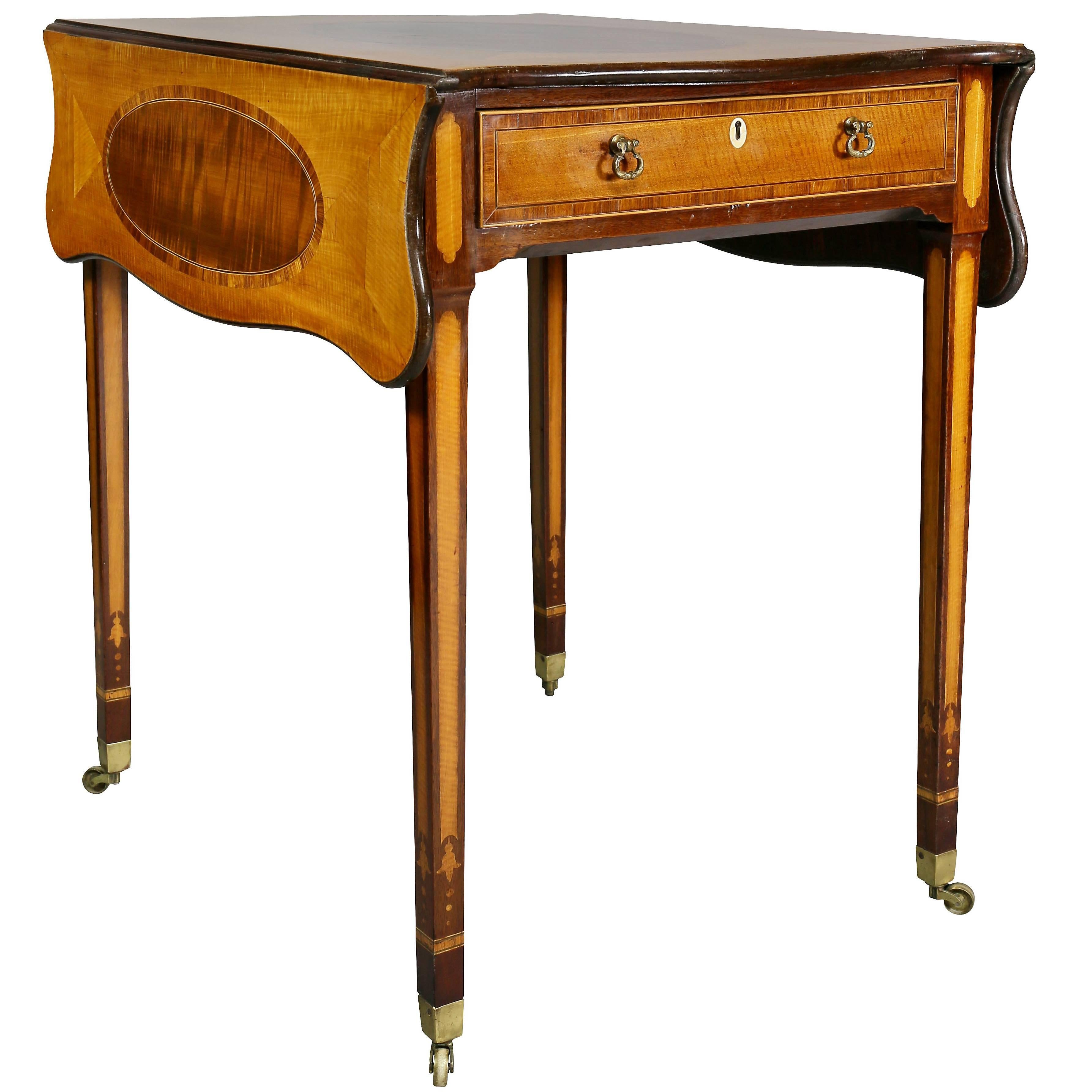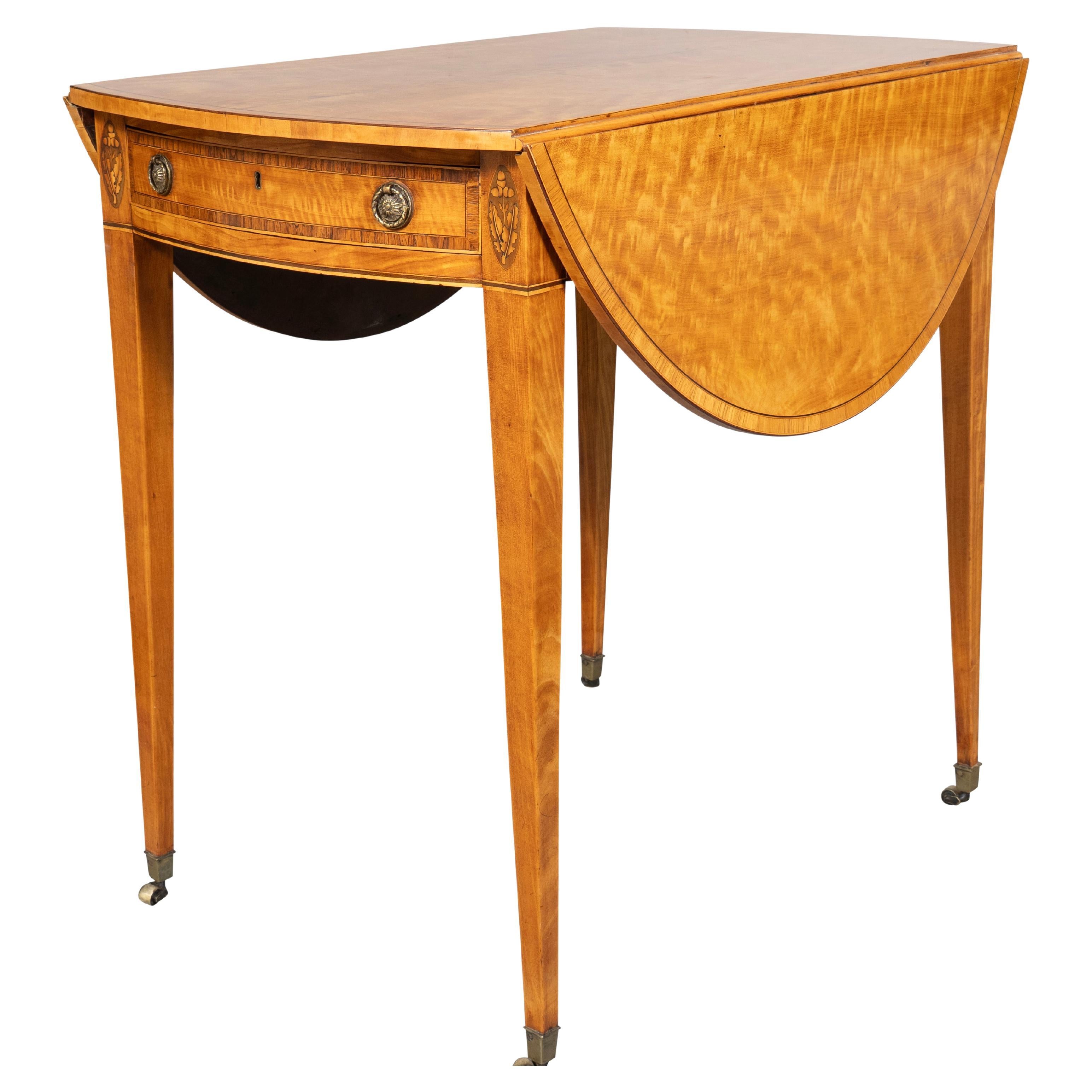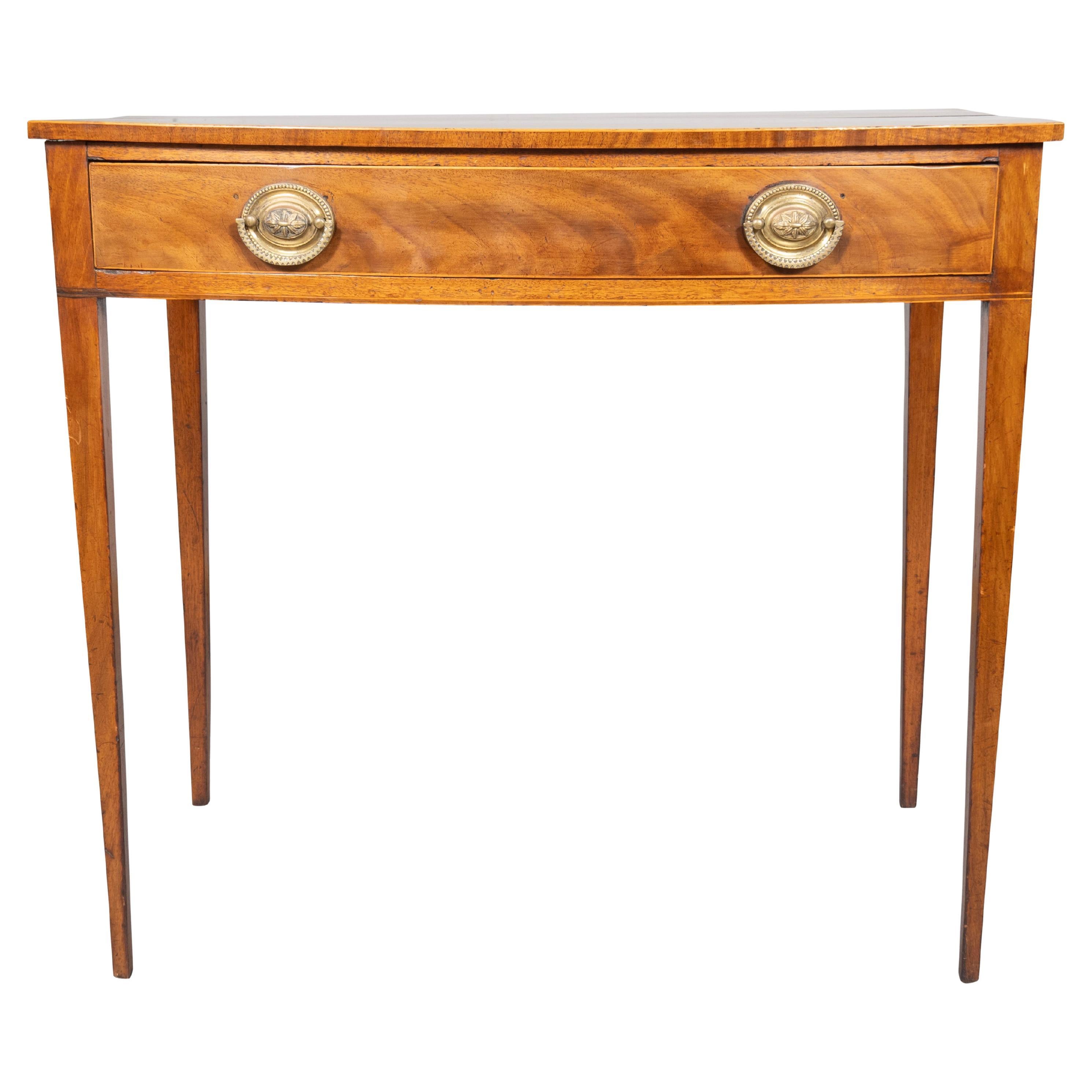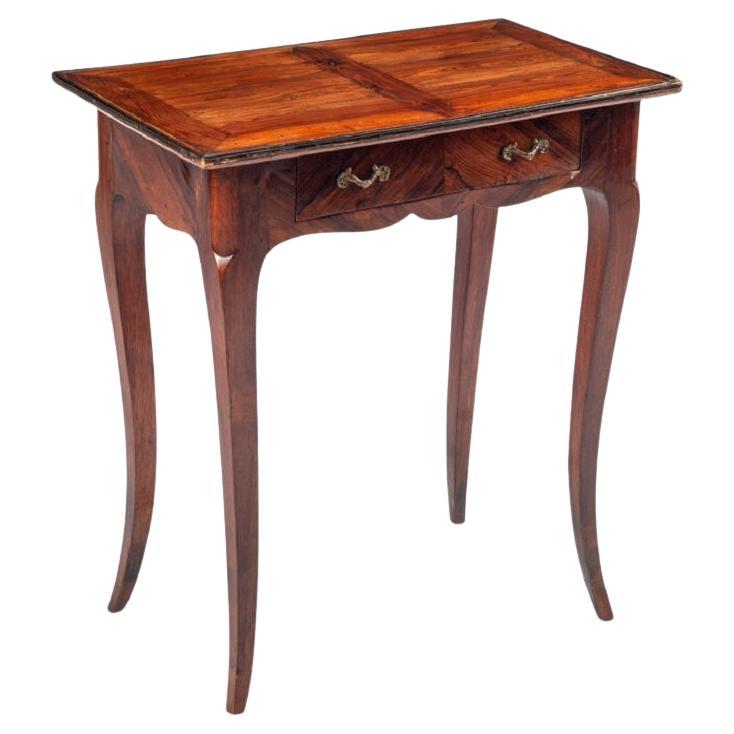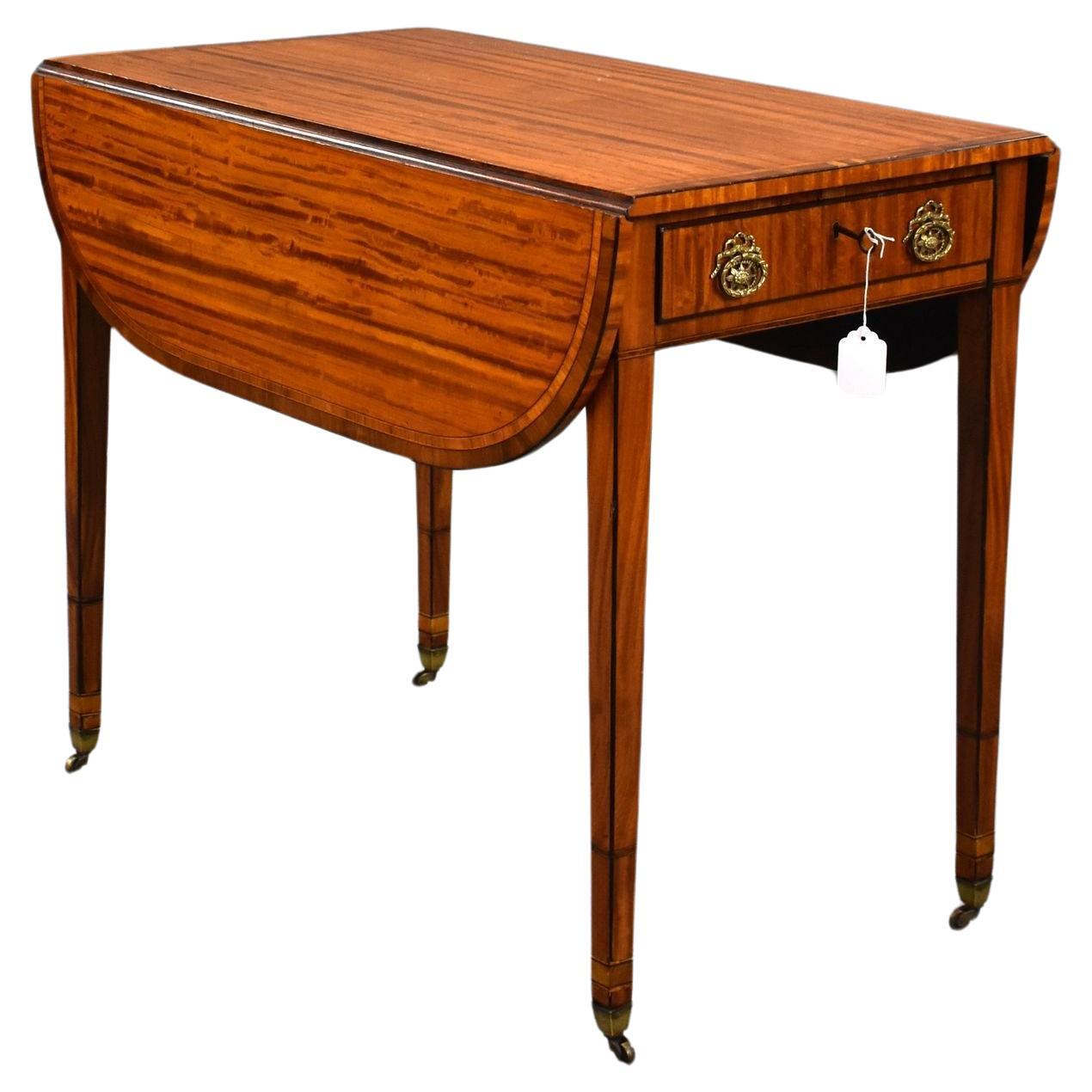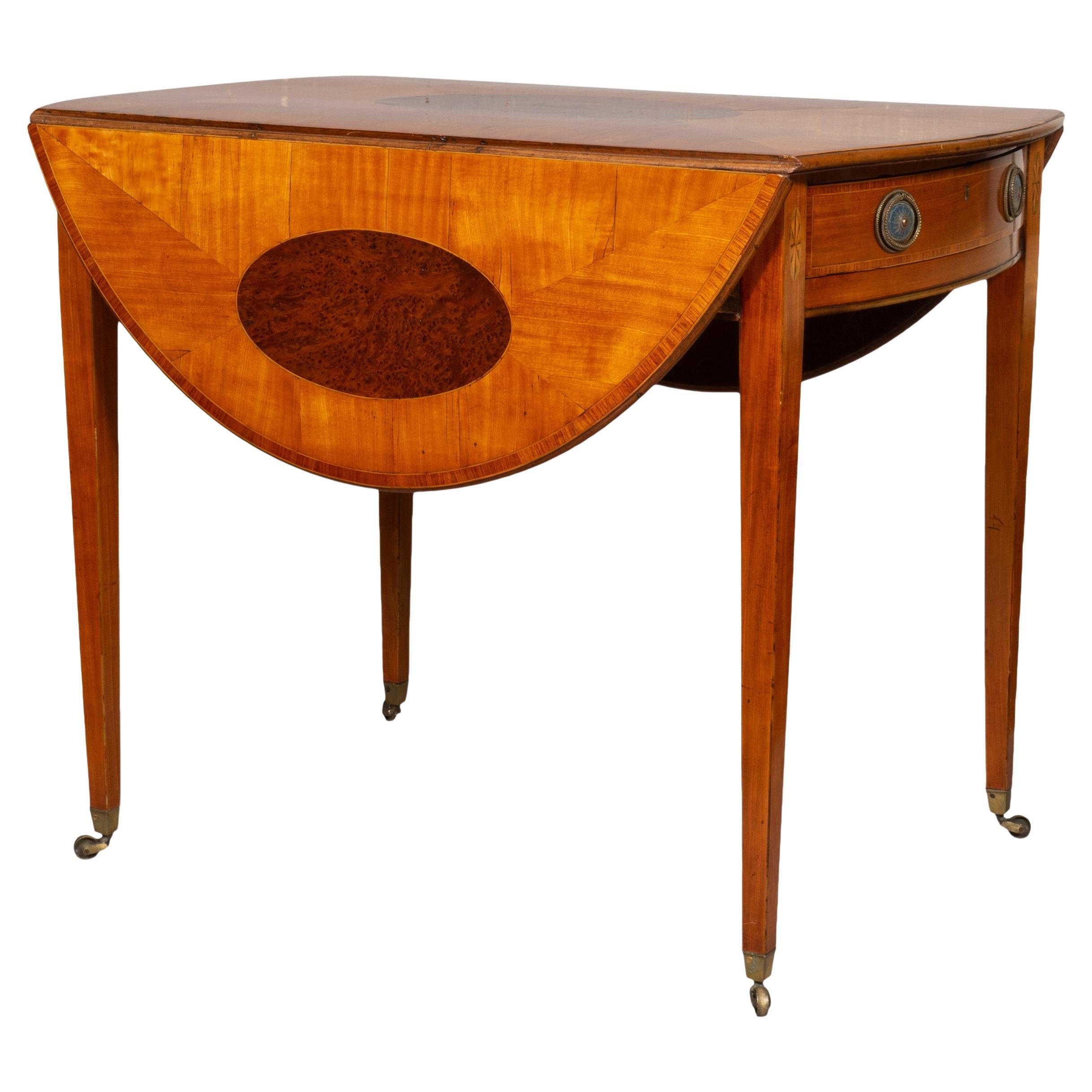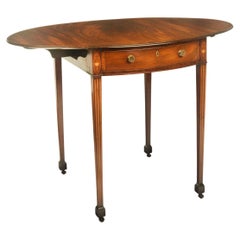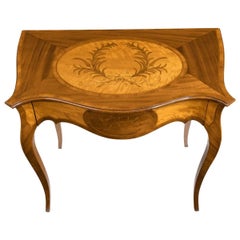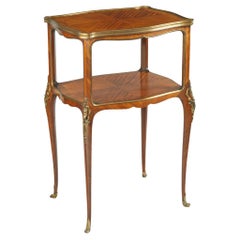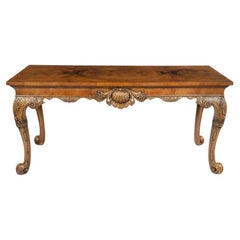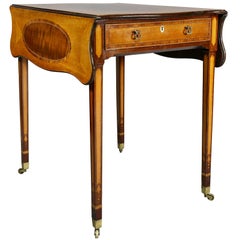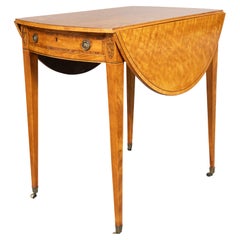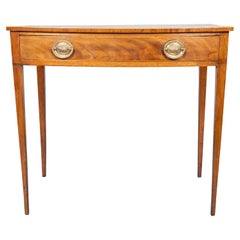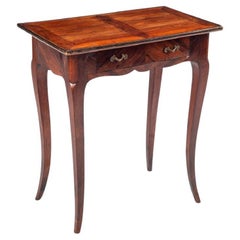Items Similar to An Unusual Sheraton Period Satinwood Demilune Side Table
Want more images or videos?
Request additional images or videos from the seller
1 of 11
An Unusual Sheraton Period Satinwood Demilune Side Table
$25,774.76
£18,750
€21,949.97
CA$35,998.32
A$39,041.03
CHF 20,505.83
MX$474,219.48
NOK 256,598.04
SEK 241,601.38
DKK 163,941.51
About the Item
An Unusual Sheraton Period Satinwood Demilune Side Table with Undertier of Outstanding Colour and Patination, c.1790, the demi lune top crossbanded with mahogany, the frieze inlaid with satinwood ovals, two with the original silvered brass handles and concealing drawers, all raised on four square tapering legs on spade feet, joined by a shaped stretcher or undertier with penwork and engraved decoration. Stamped on the base with an ‘R’ belowan earl’s coronet. English, circa 1790.
Provenance
Most probably the collections of the Earls of Radnor at Radnor House, Coleshill or Longford Castle Michael Lipitch Ltd, sold in his single owner sale at Sotheby’s 22nd of May 1998 Later acquired by Eddy Bardawil Antiques, Kensington Church Street
Of satinwood with mahogany crossbanding and with inlaid satinwood ovals on the frieze. The table incorporates two central drawers with silvered brass handles and the four square-sectioned legs have the typical Sheraton period taper and are joined by a shaped stretcher or undertier which has penwork and engraved decoration on it. The table stands on four spade feet.
On the base of the table is a stamp in the form of a capital R underneath an earl’s coronet. Assuming that the table was supplied to an English family, which seems almost certain, there are surprisingly few candidates for the use of this mark which was presumably applied as a sign of ownership, probably when an inventory was taken and contents of a house were divided or moved to other properties. It is highly likely, therefore, that this stamp records previous ownership of this piece by the Earls of Radnor, based at Radnor House in London and Coleshill and Longford Castle in the provinces. A specialist button dealer is currently offering a large number of late 18th and early 19th century hunting coat buttons made by the firm of Firmin and Sons on the Strand. These buttons are still attached to the original pattern sheet with details of the monograms and abbreviations recorded. One of these buttons shows an earl’s coronet above a capital R and is annotated ‘Earl of Radnor’. Additionally, a bookbinding for one of the ladies of the family is recorded in the University of Toronto armorial bindings database and utilises the R for Radnor as part of the monogram, rather than the owner’s given name
This table is of the popular demilune shape but has a number of unusual features. It is of much greater depth than is usually the case, meaning that the drawers in the frieze offer considerable storage space. It may well be that it was intended as a serving table and that these drawers could have been used for storing cutlery or other dining accessories. The square tapering legs are joined by an undertier or stretcher which has penwork decoration of a patera with central feathered boss. This feathered boss design is generally believed to have become popular in England due to the publication of Robert Wood’s The Ruins of Palmyra in 1753. Firms such as Ince and Mayhew made extensive use of this motif and it was incorporated in to many furniture and architectural designs of the period by the likes of Robert Adam and Sir William Chambers.
The shape of the undertier is highly unusual, the incurved sides being reminiscent of the stretchers used on a series of Pembroke tables attributed to the Marlborough maker Henry Hill. One of Hill’s clients was the Earl of Radnor though only one bill for his work, dated 1772 and for a single item, survives. It is likely that more furniture was supplied over the years and it is just possible that this piece could have been the work of this talented maker, especially if the stamp on the base of the piece does indeed indicate a Radnor provenance. Although the table top doesn’t incorporate the trademark marquetry and parquetry with which the maker is closely associated today, the overall quality of the table and its unusual feature set suggests a top quality maker based outside of London and Hill could be a candidate.
This table has acquired a truly outstanding colour and patination, the satinwood having aged
beautifully. The timbers used throughout are of fine figure and the carcase of the piece incorporates many oak elements, always a sign of fine quality.
The table is clearly related to Thomas Sheraton’s designs for pier tables published in his Drawing Book in 1791 but designed to be a more practical and sturdy piece. The quality of the construction and timbers suggests a very good maker, quite probably in London.
- Dimensions:Height: 34 in (86.36 cm)Width: 44 in (111.76 cm)Depth: 18 in (45.72 cm)
- Style:George III (In the Style Of)
- Materials and Techniques:
- Place of Origin:
- Period:
- Date of Manufacture:Circa 1790
- Condition:Wear consistent with age and use.
- Seller Location:Lymington, GB
- Reference Number:1stDibs: LU973042406172
About the Seller
5.0
Recognized Seller
These prestigious sellers are industry leaders and represent the highest echelon for item quality and design.
Established in 1982
1stDibs seller since 2013
136 sales on 1stDibs
Typical response time: 2 hours
Associations
LAPADA - The Association of Arts & Antiques Dealers
- ShippingRetrieving quote...Shipping from: Lymington, United Kingdom
- Return Policy
Authenticity Guarantee
In the unlikely event there’s an issue with an item’s authenticity, contact us within 1 year for a full refund. DetailsMoney-Back Guarantee
If your item is not as described, is damaged in transit, or does not arrive, contact us within 7 days for a full refund. Details24-Hour Cancellation
You have a 24-hour grace period in which to reconsider your purchase, with no questions asked.Vetted Professional Sellers
Our world-class sellers must adhere to strict standards for service and quality, maintaining the integrity of our listings.Price-Match Guarantee
If you find that a seller listed the same item for a lower price elsewhere, we’ll match it.Trusted Global Delivery
Our best-in-class carrier network provides specialized shipping options worldwide, including custom delivery.More From This Seller
View AllA George III mahogany Pembroke table
Located in Lymington, Hampshire
A George III mahogany Pembroke table, the oval top with two hinged flaps above a single frieze drawer, decorated with rosewood crossbanding, raised on square section tapering legs wi...
Category
Antique Late 19th Century English George III Drop-leaf and Pembroke Tables
Materials
Mahogany
Victorian Inlaid Satinwood and Kingwood Table in the Style of Hepplewhite
Located in Lymington, Hampshire
A Victorian inlaid satinwood and kingwood table in the style of Hepplewhite, the serpentine top above a single disguised frieze drawer raised on slender shaped legs, the top decorate...
Category
Antique 19th Century British End Tables
Materials
Kingwood, Satinwood
A French two tier kingwood marquetry side table
Located in Lymington, Hampshire
A French two tier kingwood marquetry side table, the top and lower shelf of shaped rectangular form, raised on cabriole legs, decorated with quarter veneers and cross-grained strapwo...
Category
Antique 19th Century French Side Tables
Materials
Kingwood
A finely carved walnut side table in the George II style by the Harry Meyers Com
By Harry Meyers
Located in Lymington, Hampshire
A finely carved walnut side table in the George II style by the Harry Meyers Company of New York and Chicago, the rectangular top with eight book-matched veneers above a concave frie...
Category
20th Century American George II Side Tables
Materials
Walnut
George III Oval Mahogany and King Wood Banded Pembroke Table
Located in Lymington, Hampshire
George III oval mahogany and king wood banded Pembroke table of lovely color. The centre panel is banded in kingwood as are the two flaps.
The whole raised on square tapering leg...
Category
Antique Early 1800s English Tables
Materials
Kingwood, Mahogany
William IV Two Tier Mahogany Table Attribruted to Gillows
By Gillows of Lancaster & London
Located in Lymington, Hampshire
A William IV two tier mahogany table attribruted to Gillows, with two circular shelves, the top one with a dished edge, supported on a reeded and...
Category
Antique 1830s English William IV Tables
Materials
Mahogany
You May Also Like
Fine George III Satinwood and Mahogany Pembroke Table
Located in Essex, MA
With rectangular top and serpentine drop leaves over a drawer raised on square tapered legs with casters.
Category
Antique 1790s English George III End Tables
Materials
Mahogany, Satinwood
George III Satinwood Pembroke Table
Located in Essex, MA
Rectangular with D shaped leaves. The frieze with a drawer flanked by oval oak leaf inlay. Square tapered legs with casters.
Category
Antique 1790s English George III Drop-leaf and Pembroke Tables
Materials
Brass
George III Mahogany Bowfront Side Table
Located in Essex, MA
Rectangular bowed top over a drawer with oval brass handles. Square tapered legs.
Category
Antique Early 1800s English George III Side Tables
Materials
Brass
Louis XV Tulipwood Side Table, 18th Century
Located in Savannah, GA
Louis XV Tulipwood Side Table, 18th Century
Category
Antique 18th Century French Louis XV Side Tables
Materials
Tulipwood
George III Satinwood Pembroke Table
Located in Chelmsford, Essex
For sale is a good quality George III Satinwood pembroke table, having a well figured top with two drop leaves, the central drawer with brass handles, and a faux drawer on the opposi...
Category
Antique 19th Century Drop-leaf and Pembroke Tables
Materials
Satinwood
Fine George III Satinwood And Amboyna Pembroke Table
Located in Essex, MA
Rectangular top with D shaped hinged leaves, the center and leaves with oval inlay over a frieze containing a conforming drawer with a pair of brass handles and an opposing identical...
Category
Antique 1790s English George III Drop-leaf and Pembroke Tables
Materials
Satinwood, Amboyna
More Ways To Browse
Hunting Coat
Stressless Computer Table
Table 70 Alvar Aalto
Thebes Side Table
Tier Spool Table
Triangle Folding Table
Turkish Tea Table
U Shaped Side Table
Vonnegut Kraft
Weiman Smoking Table
Wohl Table
Ziggy Baxter
Antique Musket
Antique Nursery Rhyme
Antique Silver Cat
Bernhard Rohne For Mastercraft
Biltmore Hotel
Black Forest Carved Table
